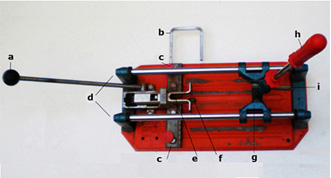TILE - Cutter by hand
ca: RAJOLA - Tallador a manual
Buy a good cutter that holds the tile in place and has measurements clearly marked on to it.
 The parts of the tile cutter:
The parts of the tile cutter:
a) The breaking handle.
b) The lateral guide which holds the tile in place.
c) Screws that hold the lateral guide in place.
d) Static supports that hold the scorer.
e) U to force down on each side of the pressure point.
f) The pressure point that moves up under the tile.
g) The bridge, moved by pushing the scoring handle.
h) Scoring handle holds the scorer and moves the bridge.
i) The scorer.
Remember: when cutting tiles in half to make borders and corners, they must be as exact as possible as they are going to form a line. If cut too short or too long, when put together this fault in length will multiply in relation to the amount used. It is much better that they are longer, if longer they can be filed down but if shorter they cannot be used!
Working Sequence:
1) Measure and mark the center of the tile with a pencil line.
2) Place the tile correctly so when the scoring handle is pulled down, the scorer touches the pencil line, tighten the screws to keeps the tile in place.
3) Lower the arm until the scorer touches the pencil line at the front. Push it forwards and downwards across the tile indenting a line. Lift up the arm and pull it back.
4) Push the handle that is attached to the U forwards this moves the U down and the pressure point under the tile up and with the force of the two the tile is divided in half.
The edges that have been cut are rough and have to be filed. If you are only dealing with a few, lay out a piece of strong sandpaper on a flat surface and rub the rough edges of the tile over it two or three times, also file and round off the corner of the upper cut edges.
If you have to sandpaper a lot, make a block to file with. It can be a flat piece of wood with the sandpaper firmly attached.
Note: when framing the edges that have been cut should always be put on the outside, so that the straight edges of the frame are against the straight edges of the tiles.
Read more about: Borders and corners / Borders (8) Separate.







